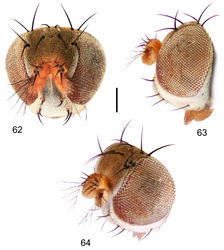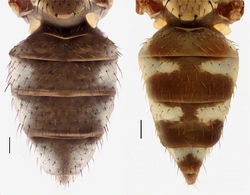Hydrochasma denticum
| Notice: | This page is derived from the original publication listed below, whose author(s) should always be credited. Further contributors may edit and improve the content of this page and, consequently, need to be credited as well (see page history). Any assessment of factual correctness requires a careful review of the original article as well as of subsequent contributions.
If you are uncertain whether your planned contribution is correct or not, we suggest that you use the associated discussion page instead of editing the page directly. This page should be cited as follows (rationale):
Citation formats to copy and paste
BibTeX: @article{Mathis2013ZooKeys363, RIS/ Endnote: TY - JOUR Wikipedia/ Citizendium: <ref name="Mathis2013ZooKeys363">{{Citation See also the citation download page at the journal. |
Ordo: Diptera
Familia: Ephydridae
Genus: Hydrochasma
Name
Hydrochasma denticum Mathis & Zatwarnicki, 2013 sp. n. – Wikispecies link – ZooBank link – Pensoft Profile
Diagnosis
This species is distinguished from congeners by the following combination of characters: Small shore flies, body length 1.15–1.70 mm. Head: Antenna mostly dark gray; parafacial silvery white, concolorous with facial coloration (Figs 62–64); gena-to-eye ratio 0.0.19–0.21. Thorax: Wing with costal vein ratio 0.68–0.71; M vein ratio 0.54–0.56. Forecoxa whitish gray, yellowish at apices; forefemur lacking a distinctive, comb-like row of stout setulae along anteroventral surface; tibiae mostly gray. Abdomen: Tergites 2–3with wedge-shaped silvery-gray areas on slate black dorsum (Fig. 71); tergite 5 of male mostly gray with blackish posterior margin. Male terminalia (Figs 65–68): Combined structures generally moderately elongate, in posterior view height 2.25× width, generally sparsely setulose dorsally, setulae sparse or lacking ventrally; epandrium lacking dorsal arch above cerci, in posterior view (Fig. 65) with apical 1/2–2/3 abruptly narrowed, parallel sided, apical process not wider than apical 1/2, apex with very narrow apicomedial cleft, in lateral view (Fig. 66) very elongate, narrow with basal 3/4 straight, apical 1/3 becoming slightly wider, slightly expanded, apex narrowly rounded, with paired subapical tooth-like structures on each process; aedeagus in lateral view (Fig. 68) very elongate and very narrow, mostly parallel sided, apical 1/8 expanded anteriorly and to a less degree posteriorly, apex irregularly rounded, in ventral view (Fig. 67) very narrow and elongate, apical 1/8 bulbously expanded, apex broadly V-shaped; phallapodeme in lateral view (Fig. 68) very narrow and elongate, rod-like, hypandrial end with narrowly pointed keel, aedeagal end very shallowly curved, in ventral view (Fig. 67) elongate, narrow, truncate, slightly and gradually expanded at aedeagal end, hypandrial end with 2 narrow crossbars; gonite in lateral view (Fig. 68) as a very shallowly curved, rod-like process, about equal in length to phallapodeme, in ventral view (Fig. 67) shallowly curved to straight, tapered at both apices; hypandrium in lateral view (Fig. 68) narrowly developed, anterior half narrowly angled, gradually expanded toward midlength, thereafter narrowed to parallel-sided, elongate extension, in ventral view (Fig. 67) moderately deeply and thickly V-shaped, with base of V rectangular, robustly developed, extended lateral arms thick, elongate, each narrowly cleft apically, bifurcate.
Type material
The holotype male of Hydrochasma denticum is labeled “ECUADOR. Prt. Or[e][l]lana: RioTiputini(0°38.2'S, 76°8.9'W), 12–26 Aug 1999, W.N.Mathis, A. Baptista, M. Kotrba/USNM ENT 00117964 [plastic bar code label]/HOLOTYPE ♂ Hydrochasma denticum Mathis & Zatwarnicki, USNM [red].” The holotype is double mounted (minuten in a block of plastic), is in excellent condition, and is deposited in the USNM. Seventeen paratypes (15♂, 2♀; USNM) bear the same label data as the holotype.
Type locality
Ecuador. Orellana: Río Tiputini (0°38.2'S, 76°8.9'W).
Other specimens examined
Neotropical. BOLIVIA. El Beni: Cavinas (12°31'S, 66°49'W), Jan 1922, W. M. Mann (2♀; USNM); Huachi (14°13.8'S, 63°32.1'W), 21 Sep, W. M. Mann (13♂, 1♀; ANSP, USNM). La Paz: Guanay (15°29.8'S, 67°52.7'W), 460 m), 13 Mar 2001, W. N. Mathis (2♂; USNM).
HONDURAS. Cortés: San Pedro Sula (8 km S; 15°25.7'N, 88°01.4'W), 25–26 Sep 1995, D. and W. N. Mathis (1♂; USNM).
PERU. Madre de Dios: Río Manu, Pakitza (11°56.6'S, 71°16.9'W; 250 m), 9 Sep 1988, W. N. Mathis (10♂, 15♀; USNM).
Distribution
(Fig. 69). Neotropical: Bolivia (El Beni, La Paz), Ecuador (Orellana), Honduras (Cortés), Peru (Madre de Dios).
Etymology
The species epithet, denticum, is of Latin derivation and means tooth, referring to the tooth-like subapical structures toward the apex of the extended epandrium.
Remarks
As implied by its species’ name, denticum, this species is distinguished from congeners by the paired, tooth-like structures located subapically on each of the ventral epandrial processes. In addition, the hypandrium in ventral view is V-shaped with robust, posterior arms that in turn are bifurcate apically.
Original Description
- Mathis, W; Zatwarnicki, T; 2013: A revision of the shore-fly genus Hydrochasma Hendel (Diptera, Ephydridae) ZooKeys, 363: 1-161. doi
Images
|

![Figures 65–68. Hydrochasma denticum sp. n. (Ecuador. Orellana: Río Tiputini) 65 epandrium and cerci, posterior view 66 same, lateral view 67 internal structures of male terminalia (aedeagus [shaded], phallapodeme, gonite, hypandrium), ventral view 68 same, lateral view. Scale bar = 0.1 mm.](https://species-id.net/o/thumb.php?f=ZooKeys-363-001-g026.jpg&width=166)

